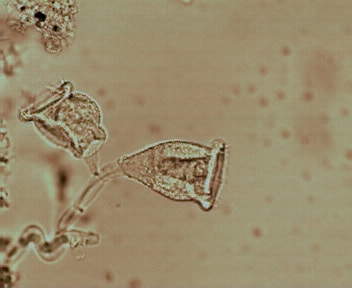- Floc - even at 10x objective (100x magnification on most microscopes), you can take note of floc size, density, and amount of non-biological particles in the MLSS. Also not clarity of water between floc - this indicates if you have smaller free bacteria or particles in solution.
- Filaments - while not as obvious without phase contrast, filaments become visible when bulking occurs. You can also make out the "fingers" of non-filamentous bulking also called Zoogleal bulking. If you have ongoing filament problems and no budget for phase contrast, invest in a Gram Stain kit. The Gram Stain helps improve the view for about $50 for many tests.
- Protozoa & other indicator organisms - these are the easily seen and interesting organisms to monitor with the microscope. Protozoa are unicellular organisms that "graze" on bacteria and other things in the water. Unlike bacteria, we can see protozoa type and activity with any microscope. Download a chart as a guide to evaluating protozoa and seeing how these guys relate to F/M, sludge age, and biomass "health". I have one here if you don't have one: https://www.biologicalwasteexpert.com/useful-information.htm
(If your microscope is in bad shape, there are cleaning/repair shops that can make it like new for much less than the cost of buying a new microscope. (I use Land, Sea and Sky here in Houston for regular cleaning and maintenance on my microscopes. If you are not local, you can arrange to ship for cleaning/maintenance.)


 RSS Feed
RSS Feed